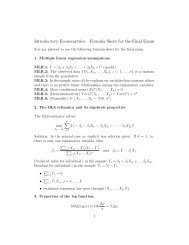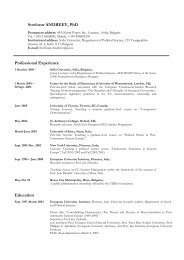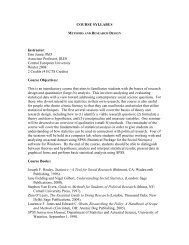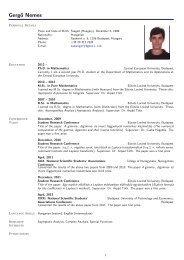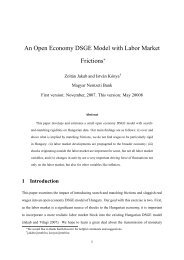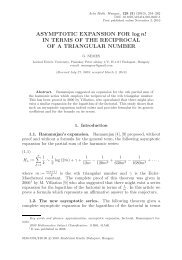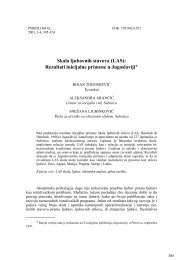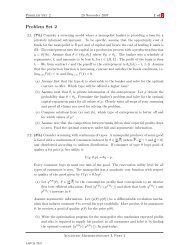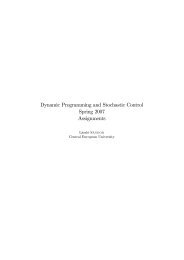Testing Gateway Theory: do cigarette prices affect illicit drug use?
Testing Gateway Theory: do cigarette prices affect illicit drug use?
Testing Gateway Theory: do cigarette prices affect illicit drug use?
Create successful ePaper yourself
Turn your PDF publications into a flip-book with our unique Google optimized e-Paper software.
696 M. Beenstock, G. Rahav / Journal of Health Economics 21 (2002) 679–698<br />
spurious gateway effect. The bootstrapped standard errors are based upon 200 resamplings.<br />
Table 8 indicates that PRSC is positive but not statistically significant, implying that there<br />
is not a causal gateway effect from cannabis to hard <strong>drug</strong>s.<br />
When the age of cannabis initiation is specified instead of PRSC in Table 8, its coefficient<br />
turned out to be negative and highly statistically significant, implying that age at hard <strong>drug</strong><br />
initiation varies directly with age at cannabis initiation. This result suggests a gateway<br />
effect from cannabis initiation to hard <strong>drug</strong> initiation. However, the test in Table 8 shows<br />
that this effect is not causal since it results from unobserved heterogeneity. People who are<br />
susceptible to <strong>drug</strong>s happen to initiate cannabis sooner, and initiate hard <strong>drug</strong>s sooner. Thus,<br />
the gateway effect is spurious.<br />
In summary, beginning to smoke at an earlier age induces earlier <strong>use</strong> of cannabis, which<br />
induces earlier <strong>use</strong> of hard <strong>drug</strong>s. The former link in the gateway chain is highly statistically<br />
significant, whereas the latter link is not robust. In these respects, the results from experiment<br />
2 complement those obtained from experiment 1.<br />
5. Conclusion<br />
Controlling for cohort and other effects, people who grew up when <strong>cigarette</strong>s were relatively<br />
cheap were more likely to smoke, and to start smoking younger. As a causal consequence<br />
they were more likely to <strong>use</strong> cannabis afterwards and to initiate cannabis sooner. Our<br />
findings from natural experimentation indicate for the first time a causal gateway effect from<br />
<strong>cigarette</strong>s to cannabis, both for sequencing and for timing. On the other hand, we <strong>do</strong> not find<br />
a causal gateway effect from cannabis to hard <strong>drug</strong>s, both for sequencing and for timing.<br />
The latter result has to be qualified by two considerations. Beca<strong>use</strong> hard <strong>drug</strong> <strong>use</strong> is rare,<br />
hypothesis testing is more difficult. Secondly, the identification of the causal gateway effect<br />
from cannabis to hard <strong>drug</strong>s was indirect.<br />
These findings imply that higher <strong>cigarette</strong> taxes will not only reduce <strong>cigarette</strong> smoking,<br />
they will also reduce cannabis consumption. However, they will not reduce the consumption<br />
of hard <strong>drug</strong>s. They further imply that if cannabis is decriminalized, and the consumption of<br />
cannabis increases (Model, 1991), it will not effect the consumption of hard <strong>drug</strong>s. Hence,<br />
if policy makers are reluctant to decriminalize cannabis for gateway reasons our results <strong>do</strong><br />
not support this position. It should be recalled, however, that just as the anti-<strong>drug</strong> legislation<br />
in the early part of the 20th century was politically inspired (Musto, 1973), so scientific<br />
reasoning in the 21st century may not sway the issue.<br />
We admit that our approach has been somewhat ad hoc. This stems from the fact that the<br />
rational addiction model refers to single substances rather than multiple substances. There<br />
is a need to extend the rational addiction model to multiple substances in order to shed<br />
theoretical light upon the gateway phenomenon. Why <strong>do</strong> some people advance to cannabis<br />
from <strong>cigarette</strong>s, or from cannabis to hard <strong>drug</strong>s, while others <strong>do</strong> not? Such a model might<br />
suggest how the <strong>prices</strong> of <strong>cigarette</strong>s, cannabis and hard <strong>drug</strong>s <strong>affect</strong> the consumption of these<br />
substances at different stages in the life cycle. In the absence of price data for <strong>illicit</strong> <strong>drug</strong>s<br />
in Israel, we have been forced to place all the burden of identification upon <strong>cigarette</strong> <strong>prices</strong>.<br />
The availability of <strong>illicit</strong> <strong>drug</strong> price data in the US makes the extension of our approach<br />
there of particular interest.



